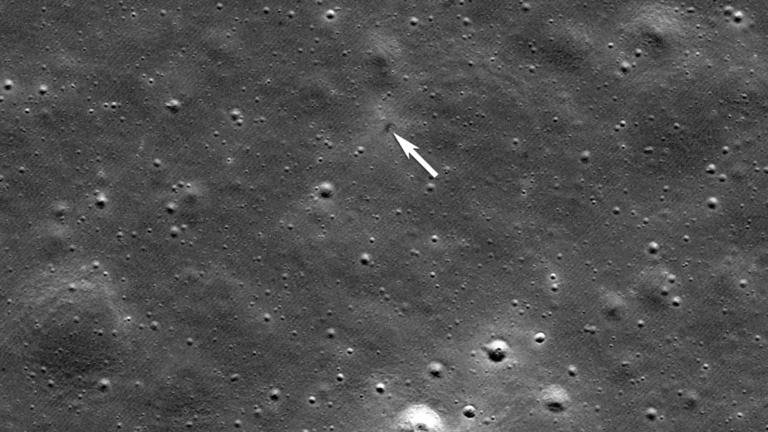NASA’s Lunar Reconnaissance Orbiter (LRO) took the first pictures of Japan’s doomed Resilience moon lander. The pictures show a grim scene: broken pieces of the lander spread out across the moon’s surface. The spacecraft, made by the Tokyo-based company ispace, was supposed to make a historic soft landing on June 5, but it didn’t and instead crashed. NASA and India’s Chandrayaan-2 orbiter have taken high-resolution pictures of the damage left behind by a dark impact scar and twisted metal scattered across the moon’s barren landscape. The failed mission shows how hard it is to explore the moon, where even a small mistake can lead to disaster.
A Mission Gone Wrong: Resilience’s Final Moments

The Resilience lander was supposed to land softly in Mare Frigoris, a huge lunar plain that is sometimes called the “Sea of Cold.” Telemetry data shows that the spacecraft’s laser rangefinder, which is an important sensor for measuring altitude, was behind in its readings. Because of this delay, the lander misjudged how fast it was descending and crashed into the surface at a deadly speed.
An ispace spokesperson confirmed, “We lost contact about 100 seconds before touchdown.” Resilience crashed into the moon at high speed without slowing down, probably breaking apart on impact. The crash sent lunar soil flying, leaving behind a dark mark that can be seen from space.
NASA’s Orbiter Spots the Wreckage

NASA’s LRO, an old satellite that maps the moon, flew over the crash site on June 11 and took pictures that showed what it looked like before and after. The new pictures show a clear dark spot where Resilience hit, surrounded by disturbed regolith, which is the moon’s dusty topsoil. The moon doesn’t have erosion like Earth does, so scars from impacts can last for millions of years.
NASA’s LRO team said, “The dark halo suggests material that was thrown out during the crash.” But the real shock came when amateur astronomers and ISRO’s Chandrayaan-2 orbiter found something that NASA had missed at first: pieces of junk scattered around.
Debris Field Discovered: How Far Did the Wreckage Fly?
India’s Chandrayaan-2 orbiter captured images with a higher resolution on June 16, and now astronomists can see at least 12 peices of wreckage strewn over the moon. Shanmuga Subramanian, who located India’s crashed Vikram lander in 2019, was the first to identify this wreckage and shared his findings on X.
Several pieces of debris seem to be placed hundreds of meters away from the main wreckage which raises questions about how violent the crash was.. Dr. Philip Metzger said, “This wasn’t just a hard landing; it was a high-speed disintegration,” explaining that this kind of damage would not have been caused by just a rough landing.
A Recurring Problem: ispace’s Second Lunar Crash

April 2023 marked the lunar crash of Hakuto-R, ispace’s lander, due to a navigational error guiding it into a crater. Although unfortunate, there is still hope for Japanese space ventures. With the SLIM lander operated by JAXA, an upside-down landing in January 2024 resulted in Japan receiving partial credit for double digital months of functioning post set down.
Emphasizing on failures in moon exploration is archaeologist Dr. Alice Gorman who said ‘Moon Landings are unforgiving’. “They amplify how critical each component’s performance really matters,” she states.
The New Moon Race: Why So Many Landers Are Crashing

In the past couple of years, there have been several attempts to land on the moon, all of which have proven unsuccessful. As of 2024:
- Firefly Aerospace’s Blue Ghost succeeded its operation on March 2.
- IM-2 by Intuitive Machines ‘died’ after crashing onto its side hours later on March 7.
- China’s Chang’e 6 won and got samples from the far side of the moon, returning in June 2024.
Concerned specialists note that the combination of government and private sector advancements has resulted in poorly designed missions with unnecessary risk. Dr. Jonathan McDowell from Harvard university said, “There’s a lot of pressure to be the first and the cheapest.” While adding, “the moon doesn’t care about time.”
What’s Next for Lunar Exploration?

Ispace is planning a third mission for 2026, even after resilience did not work. As for NASA’s Artemis program, it aims to have humans visit the moon by 2026 but will only do so if their lading SpaceX and Blue Origin landers perform as expected.
Dr Metzger remarked: “The moon is the ultimate testbed. Every crash teaches us something new.” For now they need to move past the hypothesis because resilience debris serves as an unforgiving reminder that space travel remains an enduring challenge.
Final Thought
More countries and businesses are racing to the moon than ever before, which raises the stakes and risks. Will the next lander make history, or will it end up in the growing graveyard of lunar wreckage? Only time and careful engineering will tell.
Sources:

Jan loves Wildlife and Animals and is one of the founders of Animals Around The Globe. He holds an MSc in Finance & Economics and is a passionate PADI Open Water Diver. His favorite animals are Mountain Gorillas, Tigers, and Great White Sharks. He lived in South Africa, Germany, the USA, Ireland, Italy, China, and Australia. Before AATG, Jan worked for Google, Axel Springer, BMW and others.




